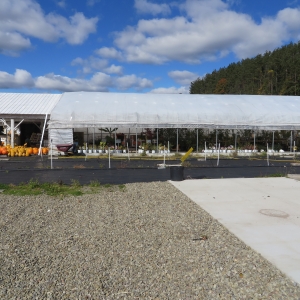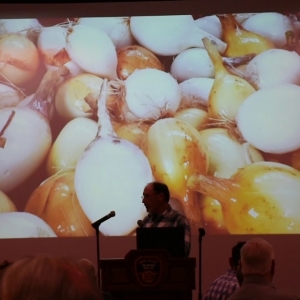Other Ag News:
While global supply chains have brought year-round abundance to families at the grocery store, it has come at a cost, particularly for small and mid-sized farmers right here at home. Consolidation of food distribution and retail has forced farmers to consider higher volume sales at lower prices, which can be difficult to consider while maintaining profits for small and mid-sized operations. However, with recent federal investments and local leadership, there has been a clear and growing desire among schools and food pantries to purchase fresh, nutritious foods from those very farms in their own backyards.
The concept of purchasing food locally with government funding is not new. However, a series of investments – beginning with the Farmers to Families Food Box Program – have spurred the development of regional food supply chains both within state borders and across state lines. This development has created stability and opened market opportunities for local businesses while bringing fresh, wholesome food to local communities. Understandably, this success has grabbed the attention of participating farmers, businesses, and food system stakeholders, in addition to the press, and most recently Congress.
Different bills, similar outcomesIn July 2025, two bipartisan bills introduced in the Senate and the House outline pathways to codify immensely popular and successful local food programs. Senators Jack Reed (D-RI) and Jim Justice (R-WV) introduced the Strengthening Local Food Security Act (S. 2338), and Representative Robert Bresnahan (R-PA-8), along with 10 of his colleagues, introduced the Local Farmers Feeding our Communities Act (H.R. 4782) the following week.
Each bill directs the US Department of Agriculture (USDA) to enter into cooperative agreements with state agencies, Tribal governments, and US territories, to provide them with funding to purchase and distribute local food to communities in need. While each program would funnel wholesome foods into food-insecure communities, the primary focus of each is to expand economic opportunities for small- and mid-sized farms, beginning and veteran farmers, while strengthening regional food networks.
The critical element of each of these bills’ potential successes is the cooperative agreement model. By empowering local and state entities to make the purchasing decisions:
- Farmers of all sizes can readily participate.
- Food dollars remain in the state, reaching areas often underrepresented in federal funding.
- Families receive fresh food that directly reflects their preferences and needs.
The two bills largely accomplish the same goal with slight variations in implementation directives. These differences are described below.
The Strengthening Local Food Security ActThe Senate bill would make non-competitive awards to States, Tribes, or territories based on need within the state, with Tribes first receiving 10% of total program funding. The eligible government agencies would be required to submit plans to USDA detailing partners responsible for implementation and the ways in which the program would grow the local food system while promoting food security. Agencies would be required to purchase all foods from local sources and at least 51% of foods from the target producers, which are defined as small and mid-size producers, beginning farmers or ranchers, veteran farmers and ranchers, and other underserved producers. These foods can be distributed to either food assistance programs or in school settings. In order to effectively administer programs, agencies could use up to 25% for program administration and technical assistance to producers, which includes supporting food safety compliance among producers. At least half of federal funding is made available to the agency before implementation, and the remainder at the midpoint of the agreement.
The Local Farmers Feeding our Communities ActIdentical to the Senate bill, the House bill would make non-competitive awards to States, Tribes, or territories based on need within the state, with Tribes first receiving 10% of total program funding. Agencies would be required to purchase only local, unprocessed, or minimally processed foods with at least 25% of those foods from small and mid-size producers, beginning farmers or ranchers, and veteran farmers and ranchers. These foods would be distributed to local food organizations to improve access to healthy and nutritious foods in communities. In the House bill, agencies would also have access to no more than 25% of their funding for program administration and technical assistance to producers, which includes supporting food safety compliance among producers, and to grow the local agricultural value chain. If program elements are not specified, it would be up to the discretion of USDA on implementation.
If either of these bills is included in a future Farm Bill, differences between them would need to be addressed by Agriculture Committee leadership.
Maple Wind Farm Richmond, Vermont Locally Tested and ApprovedFor more than 25 years, USDA has directed numerous pilot projects, created statutorily-directed local food programs, and explored ways to strengthen market channels between farms and kitchen tables. Each of them has had various forms of success, but none that could be assessed at a national scale.
One of USDA’s latest initiatives, the Local Food Purchase Assistance Program, utilized a cooperative agreement model, providing funding directly to states, Tribes, and territories to purchase local food for nutrition and food assistance programs. While the cooperative agreement model is not a new approach, to date, most federal nutrition programs provide foods to communities via USDA’s commodity procurement and distribution network.
By instead supporting localities and stakeholders on the ground to manage all food purchases, states and local communities have achieved undeniable success and significant economic impact:
- By December 2024, localities had purchased more than $400 million in new direct food purchases, which generated $747 million in economic activity.
- Local program design meant significantly fewer barriers for participation, compared to food purchases being made by USDA. Nearly 10,000 unique farmers – big and small- were able to participate. Localities purchased a wide variety of locally produced foods, such as fresh produce, meat, dairy, eggs, fish, and more.
- Many participating farmers were small, mid-size, or beginning farmers, and purchases allowed them to scale their operations, which led to hiring new employees and on-farm investments, such as cold storage, high tunnels, and other infrastructure.
Hamid Pezeshkian, the owner and operator of Flametree Farms in Vista, CA, shared “Thanks to reliable local purchasing agreements, we’ve been able to reinvest into improving our irrigation system, and planting a few new fruit trees; we’ve also been able to get the entire orchard covered with fresh native mulch which should help in organically improving the soil fertility and fruit quality this season.”
Sharifa Tomlinson, the owner of Arrowrock Farm in Ohio, explained the magnitude of their ability to scale, “The reason why Ohio CAN is a great source for us and for us financially is one, we can sell a lot of chickens at one time which brings us in a little bit more financial support and a stream of revenue. Because of CAN, I was able to grow my operation. We started off with raising 30 meat chickens a year…and this year we’re up to 400 at any given time.”
Securing the future of local food systemsThe local food programs laid out in the Strengthening Local Food Security Act and the Local Farmers Feeding our Communities Act would create new, reliable markets for farmers while better connecting them with consumers and families in their communities. These investments will catalyze and strengthen a burgeoning local food sector that can expand beyond federal nutrition programs.
But in order to succeed, Congress must adequately invest in local food economies, and not just commodity markets. Congressional members need to hear how local foods are important to your business, health, and community well-being.
Click here to ask for your Congressional Member’s SupportThe post Congress Wants Local Food Back on the Menu appeared first on National Sustainable Agriculture Coalition.
(Washington, D.C., September 10, 2025) – The U.S. Department of Agriculture (USDA) is delivering on its commitment to support child health and American agriculture by opening applications for the Fiscal Year (FY) 2026 Patrick Leahy Farm to School Grants. Through this grant opportunity, USDA will invest up to $18 million in farm to school projects that connect farmers to USDA’s child nutrition programs through local food procurement, agricultural education, school gardens, and more.
(Washington, September 9, 2025) – The Make America Healthy Again Commission today released the Make Our Children Healthy Again Strategy, a sweeping plan with more than 120 initiatives to reverse the failed policies that fueled America’s childhood chronic disease epidemic. The strategy outlines targeted executive actions to advance gold-standard science, realign incentives, increase public awareness, and strengthen private-sector collaboration.
Interested in improving your technical and business knowledge? Enroll now for Cornell Small Farms Program online courses to gain valuable skills on countless topics, including finances, cattle, pigs, mushrooms, land health, and stress management. Live webinars for our first block of courses will begin next week.
Our online courses are designed to be flexible and user-friendly. All course materials are stored on our single, easy-to-use web platform, which you can access for life after enrolling in a course. Tune in to weekly webinars to hear from experts and ask questions in real time, and complete all other course reading and assignments when it works for you.
One new addition to our suite of courses this year is the new self-paced course on Foundations of Beef Production. This new mini-course covers the most basic beef knowledge you need, from breeds to terminology to production systems. It is led by expert educators Betsy Hicks and Abbey Birchenough, and includes two free additional office hour sessions with them. If you are starting from zero, we recommend taking this mini-course and then enrolling in the live-instructed Beef Cattle Production and Management, which begins on Wednesday, September 24.
Registration is open now for all courses. Make sure to enroll for our first block of classes, which will run for six weeks beginning the week of September 22.
BF 101: Starting at Square One
Mondays from 6:30 p.m. – 8 p.m. ET
So you’re thinking about starting a farm, but feeling overwhelmed by all the decisions? Have your online searches turned up piles of information, but you still feel a bit lost? This course is designed to assist new and aspiring farmers in taking the first steps in thinking through farm start-up (whether you already have land access or not).
Mondays from 7 p.m. – 8:30 p.m. ET
There is only one guarantee in agriculture or other land-based businesses: “When we improve land health we realize improvements in production, profitability, and social well-being.” This course will teach farmers how to measure improved land health through reading the land as we walk across it, as well as conducting various biological monitoring practices, from simple to more complex.
BF 101: Cómo Iniciar su Negocio Agrícola
Martes, de 6:30 p.m. a 8 p.m., hora del este
¿Está pensando en comenzar un negocio agrícola propio, pero se siente confundido por todas las decisiones que esto involucra? ¿Sus búsquedas en línea han arrojado mucha información, pero todavía se siente un poco perdido? Este curso está diseñado para ayudar a todas las personas que desean iniciar o son agricultores nuevos a dar los primeros pasos para iniciar su propio negocio agrícola (finca, rancho, granja), ya sea que tenga acceso a la tierra o no. Este curso es 100% en Español.
BF 149: Identifying and Partnering with Mushrooms in Farms, Gardens and Forests
Tuesdays from 6:30 p.m. – 8 p.m. ET
Mushrooms are a fascinating set of organisms that are quickly gaining popularity for a wide range of applications from food to medicine to cleaning up toxic pollutants. This course offers an overview of foundational knowledge needed to understand how mushrooms might play a role in your farm and/or greater community. Learn the basic biology and life cycle, proper harvest and identification, and examples of how humans are using mushrooms.
BF 204: QuickBooks for Farmers
Tuesdays from 7 p.m. – 8 p.m. ET
This course is an introduction to QuickBooks, designed to provide an overview of the QuickBooks Pro software application. It will cover the basic features, such as sales tax, inventory, invoicing, adjustments, and year-end procedures. Students will gain hands-on experience in the concepts presented, as well as guidance on applying the concepts to their own farm bookkeeping.
BF 233: Beef Cattle Management
Wednesdays from 6:30 p.m. – 8 p.m. ET
Having a successful cattle business is about much more than just buying a few head and putting them in a field. If you want to turn a profit, you need to think carefully about your goals, marketing strategies, appropriate breeds, and many more details. Over this six-week course, you’ll get a much clearer idea of what is involved, whether it’s the right fit for you, and if it is, what steps you need to take to get started. Now also available as a bundle with our new self-paced Foundations of Beef Production course.
BF 210: Stress Reduction for Farmers
Wednesdays from 7 p.m. – 8:30 p.m. ET
Interested in creating a farm that runs smoothly, having time for off-farm interests, and reducing your overall stress? In this course, farmer Allyson Angelini shares Holistic Management tools that will help you approach farming with intention, an eye for efficiency, and in ways that are more self-supportive. Learn to conduct an annual review, establish priorities, create an achievable plan, and connect with peers for support and encouragement.
BF 138: Getting Started with Pastured Pigs
Thursdays from 6:30 p.m. – 8 p.m. ET
Pigs can function as a profitable stand-alone enterprise or can be integrated into your existing farm structure to provide a variety of products and utilize marginal lands that would otherwise go unused. This course will guide beginning farmers through the production and marketing of pigs raised in pasture settings.
In our ongoing commitment to equitable access to education, we have maintained tiered pricing for our courses based on household size and income. We also offer scholarships for eligible farmers in New York who face an entry barrier to farming, and for military veterans in New York State.
In recent years we added “Growing Uncommon Fruit,” which will help you determine whether incorporating uncommon fruit into your operation is the right decision for you, “Goat Production,” which will guide beginning farmers through the production and marketing of goats for dairy, meat and fiber, and “Identifying and Partnering with Mushrooms in Farms, Gardens and Forests” to teach you basic ID, species, life cycle, and potential applications of mushrooms to solve community-level challenges. Other newer additions include “Stress Reduction for Farmers,” which offers strategies for streamlining your farm; “Access to Capital” for anyone seeking funding for a farm enterprise; “Cut Flower Production” on the business of flower farming; a course on “Beef Cattle Management;” a primer on “Social Media & Online Marketing” for your farm business; and a 4-week intensive in how “Reading the Land” can help you monitor its health.
You can browse all of our course offerings on our website. You can learn more about our courses, including answers to common questions, on our course FAQ.
The post From Business to Beef, Learn New Skills with Our Online Courses appeared first on Cornell Small Farms.
(Washington, D.C., September 5, 2025) – Today, U.S. Deputy Secretary of Agriculture Stephen Alexander Vaden in North Carolina met with agricultural leaders and producers and announced additional U.S. Department of Agriculture (USDA) assistance to help producers recover from Hurricane Helene. Deputy Secretary Vaden signed a block grant agreement with the North Carolina Department of Agriculture and Consumer Services (NCDA&CS) that provides recovery assistance to eligible North Carolina farmers. In July, U.S. Secretary of Agriculture Brooke L.
(Washington, D.C., September 3, 2025) – U.S. Secretary of Agriculture Brooke L. Rollins today signed a new five-year contract for American made fire retardant with Perimeter Solutions, supporting the U.S. Forest Service and Department of the Interior’s aerial wildland fire suppression programs. The agreement secures significant savings, putting the American taxpayer first, while strengthening our manufacturing base by keeping fire-retardant production made in America.
(Washington, D.C., September 3, 2025) – The U.S. Department of Agriculture (USDA) is investing more than $8 million for five new projects to reduce wildfire risk, protect water quality, and improve forest health across the nation. This expands President Trump’s mission to improve the lives of American families, support rural communities, and expand domestic timber production.
The Cornell Small Farms Program team is growing! We are excited to share the application for our newest team member, a Bilingual Small Farm Educator to be based in Cornell’s Hudson Valley Research Laboratory (CHVRL), located in Highland, NY.
Through the efforts of the Futuro en Ag project, our farmer audience has grown to include many Spanish-speaking farmers. We aim to welcome new farmers and continue to expand our Spanish language educational programs and resources through this important position.
The Bilingual Small Farm Educator will be supervised by the Bilingual Program Coordinator, who will play a lead role in providing education, technical assistance, and culturally responsive support to Spanish-first and small-scale farmers across NYS. The educator will lead workshops, farm visits, and programs on topics such as crop production, soil health, climate resilience, and farm business planning. This work is essential to creating pathways for farmer career growth, business ownership, and long-term success in agriculture. Additionally, a critical aspect of this work is expanding Spanish-speaking farmer audience engagement with the Cornell Small Farms Program through effective bilingual promotional and marketing strategies of educational opportunities.
The Bilingual Small Farm Educator is a full-time position, based in Highland, NY. We are currently welcoming applications through October 8, 2025, and we look forward to meeting you!
We also encourage you to share this announcement within your own networks, especially with individuals who may have the skills and passion this position requires.
If you have any further questions, contact Mildred Alvarado at ma853@cornell.edu.
El equipo de Cornell Small Farms Program está creciendo. Nos complace compartir la convocatoria para nuestro/a nuevo/a integrante: Educador/a Agrícola Bilingüe, con sede en el Laboratorio de Investigación del Valle de Hudson de Cornell (CHVRL), ubicado en Highland, NY.
Gracias al proyecto Futuro en Ag, cada vez más agricultores hispanohablantes se suman a nuestra comunidad. Con esta posición queremos dar la bienvenida a más productores y continuar fortaleciendo nuestros programas y recursos educativos en español.
El/la Educador(a) Agrícola Bilingüe trabajará bajo la supervisión de la Coordinadora del Programa Bilingüe, quien tendrá un papel clave en brindar educación, asistencia técnica y apoyo culturalmente pertinente a agricultores cuya lengua principal es el español y a pequeños productores en todo el estado de Nueva York. El/la educador(a) liderará talleres, visitas a fincas y programas sobre temas como producción de cultivos, salud del suelo, resiliencia climática y planificación de negocios agrícolas. Este trabajo es esencial para crear caminos de desarrollo profesional, propiedad de negocios y éxito a largo plazo en la agricultura. Además, un aspecto fundamental de esta labor será ampliar la participación de agricultores hispanohablantes en el Cornell Small Farms Program mediante estrategias bilingües eficaces de promoción y mercadeo de las oportunidades educativas.
Este es un puesto de tiempo completo, con sede en Highland, NY. Estamos recibiendo solicitudes hasta el 8 de octubre de 2025 y esperamos conocerle pronto.
Le invitamos a compartir este anuncio en sus redes, especialmente con personas que tengan las habilidades y la pasión que este puesto requiere.
Si tiene preguntas, por favor contacte a Mildred Alvarado en ma853@cornell.edu.
The post Join Our Team: Cornell Small Farms Hiring Bilingual Educator appeared first on Cornell Small Farms.
(Washington, D.C., August 28, 2025) – U.S. Secretary of Agriculture Brooke L. Rollins today announced a commitment to new actions (PDF, 1.2 MB) to increase the number of rural food animal veterinarians across the U.S. and recruit new veterinarians to join the U.S. Department of Agriculture (USDA) in their role to protect American ranchers, animals, and our food supply.
On July 24, 2025, US Secretary of Agriculture Brooke Rollins released a memo (SM-1078-015) describing the planned reorganization of the US Department of Agriculture (USDA) staff. This reorganization plan was drafted without any consultation with farmers or other stakeholders. While the reorganization plan does not directly include planned layoffs or reductions in force (RIF), USDA has already lost at least 18,000 staff since January 2025. If the reorganization moves forward as planned, it will likely result in the loss of thousands more staff.
After swift bipartisan pushback to the proposed reorganization, USDA opened an impromptu and unofficial public comment opportunity. The National Sustainable Agriculture Coalition (NSAC) encourages organizations and individuals to submit their comments, questions, and concerns regarding the reorganization to USDA at reorganization@usda.gov by August 31, 2025. NSAC also notes our concern that the opportunity for public comment has not been formally provided through the Federal Register, as is standard practice for proposals of this scope.
The dedicated USDA staff powers the Department to meet its mission to serve farmers and other stakeholders. Unfortunately, recent history shows that staffing losses directly reduce and delay USDA’s services to stakeholders. When USDA relocated the Economic Research Service (ERS) and National Institute of Food and Agriculture (NIFA) offices in 2019, the agencies lost more than half of their staff. According to the Government Accountability Office (GAO), these staff losses cut the number of reports and articles generated by ERS staff in half, led to the loss or delay of several vital industry reports, and led to delays and suspensions of several grant programs and payments. It has taken years for the agencies to rebuild their capacity and attempt to replace the lost institutional knowledge needed to serve American agriculture and stakeholders. USDA must avoid replicating the problems of these previous staffing disruptions and further exacerbating the already ongoing staffing crisis at the agency.
This is the first blog post in a series discussing the loss of USDA staff since January 2025 and the expected impacts of the proposed USDA reorganization across issue areas. This post sets the stage by examining the overall department staffing losses and the losses experienced by each state.
USDA Staff Work in Your CommunitiesIn recent years, USDA staffing numbers have hovered around 100,000 employees. In September 2024, the Office of Personnel Management (OPM) reported that USDA had 98,473 employees. Across Republican and Democratic administrations, USDA staffing levels have remained fairly consistent – George W. Bush oversaw the department’s largest workforce, while Obama trimmed it back – until the Trump administration broke sharply with precedent by presiding over recent steep cuts. The first Trump administration saw a historical low in USDA-wide staffing in September 2019 following the relocation of both the ERS and NIFA from Washington, DC to Kansas City, MO. While staffing levels recovered slightly during the Biden administration, they remained below typical levels, and the department has had little time to rebuild the lost institutional knowledge and relationships with stakeholders.
Figure 1: USDA Staffing Levels
- Data from the Office of Personnel Management
While the reorganization memo claims that major disruptions are justified to bring “the USDA closer to its customers,” the reality is that the overwhelming majority of USDA staff are already living and working outside the capital region.
Figure 2: USDA Staff by State
!function(){"use strict";window.addEventListener("message",function(a){if(void 0!==a.data["datawrapper-height"]){var e=document.querySelectorAll("iframe");for(var t in a.data["datawrapper-height"])for(var r,i=0;r=e[i];i++)if(r.contentWindow===a.source){var d=a.data["datawrapper-height"][t]+"px";r.style.height=d}}})}();- An additional 1,063 USDA staff work throughout the US, but their location was suppressed by OPM to protect employee privacy; 794 USDA employees work in US territories, and 336 outside the US.
USDA has already lost at least 18,000 staff since January 2025. More than 15,000 USDA employees left the department through DOGE’s so-called Deferred Resignation Program (DRP). The DRP offered federal employees fully paid administrative leave through September 2025 if employees voluntarily resigned from their positions. Approximately 3,876 USDA employees accepted DOGE’s first round DRP offer, and an additional 11,298 USDA employees resigned in the second round of DRP. Many of these employees have years of experience and irreplaceable expertise.
In addition to staff who have resigned through DRP, approximately 2,827 USDA staff members separated from the Department between January and March 2025, according to OPM. These separations include employees who quit, experienced a “reduction in force”, retired (early, voluntary, or for disability), were terminated due to an expired appointment or contract, transferred out, or had some other separation from the department. The separated employees have an average length of service of more than 12.4 years, with 38% of separated employees having more than ten years of service.
The table below shows the number of employees in each USDA agency, the number who accepted the deferred resignation offer, and the number of other separated employees.
Table 1: USDA Deferred Resignation and Separations by Agency
- The DRP data differentiates between general FSA employees and FSA county employees; FSA county employees are typically not general service employees.
Every agency at USDA has experienced staff resignations and separations. Some have been hit particularly hard, like the Office of Partnerships and Public Engagement (OPPE), losing 53% of its staff to DRP and separations, Rural Development losing 36% of its staff, and the Natural Resources Conservation Service (NRCS) losing 22% of its staff. Reasons for these disparities are not fully understood. Future posts in this series will explore these agency losses and impacts in greater depth.
Staff Losses Are In Your Communities Despite claiming to prioritize serving farmers and to “bring USDA closer to its customers”, 94% of USDA employees who resigned were located outside of Washington, DC. Every state and territory lost USDA staff during DRP, as the map below shows, and every state except three (Hawaii, Oregon, and California) had more than 10% of its USDA staff resign.Figure 3: USDA Staff Losses by State
!function(){"use strict";window.addEventListener("message",function(a){if(void 0!==a.data["datawrapper-height"]){var e=document.querySelectorAll("iframe");for(var t in a.data["datawrapper-height"])for(var r,i=0;r=e[i];i++)if(r.contentWindow===a.source){var d=a.data["datawrapper-height"][t]+"px";r.style.height=d}}})}();- An additional 73 USDA staff in US territories also accepted the Deferred Resignation Program
Like resignations, 94% of the separations between January and March 2025 were outside of Washington, DC. Every US state and territory had USDA staff separate between January and March 2025, adding to the loss of vital USDA staff.
Reorganization Will Further Undermine USDA Services
USDA staff are dedicated public servants who support America’s farmers, ranchers, and rural communities. They work in every state and territory and bring their expertise and energy to tackling some of America’s greatest challenges.
Since January 2025, USDA has already lost at least 18,000 employees. These staff losses mean less capacity to serve farmers and rural communities. The major staff losses experienced during the previous relocation of ERS and NIFA led directly to lost productivity and poor service to stakeholders. Those agencies lost their most experienced staff, and it took years to rebuild their internal capacity.
The USDA is already experiencing a staffing crisis which means longer wait times for farmers and widespread cutbacks to programs serving American agriculture. The reorganization of USDA will further devastate the department’s workforce and ability to fulfill its mission to serve farmers and rural communities. Secretary of Agriculture Brooke Rollins has said that she expects between 50-70% of USDA staff to accept the relocation required by reorganization, indicating that thousands of experienced and knowledgeable staff may soon choose to leave the Department, further undermining USDA’s ability to provide vital services to stakeholders.
The post USDA Staffing Crisis: Mass Departures Undermine Local Ag Support appeared first on National Sustainable Agriculture Coalition.
Pages
Signup for the Ag Newsletter
Get the freshest farm news, events and updates from in and around Cattaraugus County, NY at least once a month! Go signup!
Other ways to stay connected:
Get Involved in Farming
Resources for Starting a Farm in Cattaraugus County
Profile of Cattaraugus County soils
Agriculture Career Exploration
Questions about farming? Find out Who to Call










